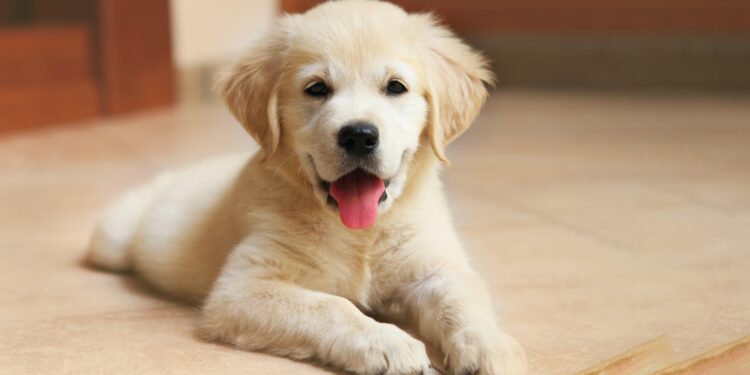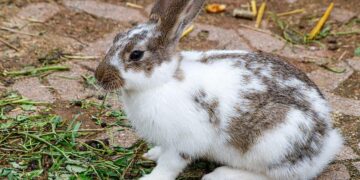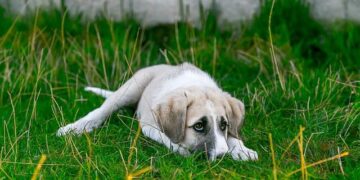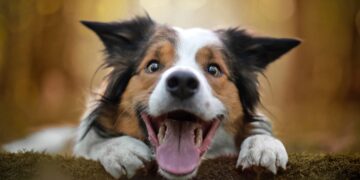Table of Contents
My name is Sarah, and for the last ten years, my life has revolved around dogs.
As an owner and groomer, I thought I knew what I was doing.
But for the longest time, I was failing my own dog, a beautiful, goofy Golden Retriever named Luna.
And I was failing her in a way that broke my heart every single time.
Luna has a magnificent coat, but it’s prone to matting.
I had an arsenal of tools—rakes, combs, brushes—all promising to be the “best dog detangler.” Yet, our grooming sessions were battles.
I remember one afternoon vividly.
I found a stubborn mat behind her ear and went to work with a popular detangling rake.
I pulled, she resisted.
I tried to be gentle, but the mat was a fortress.
Then, she let out a sharp yelp that cut right through me.
She scrambled away, her eyes wide with fear and pain, and hid under the bed, trembling.
In that moment, I felt like the worst dog owner on the planet.
I was the source of her pain.
My attempts to care for her were traumatizing her, turning our grooming time into a source of anxiety that was damaging our bond.1
This became a vicious cycle: the more painful it was, the more she feared it; the more she feared it, the harder it was to groom her; and the less I groomed her, the worse the mats became.
I was trapped, and I knew something had to change fundamentally.
My breakthrough didn’t come from a pet store or a grooming seminar.
It came from a place I never expected: the dust and dirt of ancient history.
The Anatomy of a Mat: Why We’re All Getting It Wrong
Before I share my epiphany, we need to talk about what a mat really is, because my failure with Luna—and the failure of so many well-meaning dog owners—stems from a basic misunderstanding.
We tend to see a mat as a single, solid object, a tangled monolith that must be conquered with brute force.
This is the “Monolith Fallacy,” and it’s why our efforts so often end in pain and frustration.
A mat isn’t a simple knot.
It’s a dense, layered structure formed when loose, dead hair gets tangled with live hair.3
This clump then traps dirt, debris, moisture, and skin oils, compacting over time into a tight, felt-like wad.4
This process is accelerated in certain breeds with long, curly, or double coats (like Luna’s), and by friction from collars and harnesses.3
What starts as a cosmetic issue quickly becomes a serious health hazard.
The dangers lurking within a matted coat are far more severe than most owners realize.
The Hidden Dangers of Matted Fur
A matted coat is not just unsightly; it is a source of constant suffering and can lead to life-threatening conditions.
- Chronic Pain and Skin Damage: Mats pull relentlessly on a dog’s skin, causing continuous discomfort and pain.4 This constant tension can lead to skin irritation, inflammation, and painful sores known as hot spots.3 The matted fur traps moisture and bacteria against the skin, creating a perfect breeding ground for bacterial and fungal infections.4
- Parasite Infestations: The dense, warm environment of a mat is an ideal hiding place for fleas, ticks, and other parasites, where they can live and breed undetected, feeding on your dog.4
- Restricted Blood Flow and Necrosis: This is one of the most terrifying risks. A mat that forms around a limb, tail, or ear can grow so tight that it acts like a tourniquet, cutting off blood circulation.1 This can lead to severe swelling, tissue death (necrosis), and in the most extreme cases, necessitates the amputation of the affected limb to save the dog’s life.3 In the ears, this restricted blood flow can cause blood vessels to burst, resulting in a painful condition called an aural hematoma.8
- Masking Underlying Disease: The dense barrier of a matted coat can hide lumps, bumps, skin abnormalities, or tumors, preventing early detection and delaying critical veterinary treatment.3
- Psychological Trauma: The constant physical pain and discomfort inevitably take a psychological toll. Dogs with matted fur can become irritable, withdrawn, anxious, and aggressive.2 They develop a fear of being touched or handled, associating human contact with pain, which severely damages the human-animal bond.11
My experience with Luna was a mild version of this trauma.
But seeing her hide from me made me realize that my approach, born from the “Monolith Fallacy,” was the root of the problem.
Trying to attack the mat as a single entity with a single tool was like trying to demolish a building with a sledgehammer—destructive, inefficient, and dangerous.
I needed a new way to see the problem.
The Epiphany: How Archaeology Taught Me to Groom My Dog
One evening, feeling defeated after another failed grooming attempt, I was mindlessly watching a documentary about an archaeological dig.
The lead archaeologist was explaining the concept of stratigraphy, the study of layers of earth, or strata, that are deposited over time.13
She pointed to a cross-section of the excavation pit, showing distinct bands of soil.
She explained the fundamental Law of Superposition: in any undisturbed sequence, the oldest layers are at the bottom, and the newest layers are at the top.15
Archaeologists don’t just dig a hole; they perform a controlled, reverse-order excavation.
They carefully remove the newest layer first, then the one beneath it, and so on, all the way down to the oldest layer.17
This meticulous process allows them to understand the history of the site, recovering fragile artifacts without destroying the context that gives them meaning.
That was my “aha!” moment.
A lightning bolt of understanding shot through me.
A mat is not a monolith.
A mat is an archaeological site on your dog’s body.
The loose, dusty fur on the surface is the newest layer, the “topsoil.” The tightly compacted, dense fur closer to the skin is the oldest, most established layer, sitting directly on top of the most fragile artifact of all: your dog’s skin.
My old approach—jamming a rake into the top and pulling—was the equivalent of driving a bulldozer through a delicate historical site.
It was bound to cause destruction and pain.
The solution wasn’t a better bulldozer; it was to stop bulldozing altogether.
I needed to become an archaeologist.
I needed to learn the art of Layered Deconstruction.
This new paradigm changed everything.
It gave me a framework that was patient, methodical, and, most importantly, humane.
It turned a painful chore into a careful, respectful process of excavation.
The Layered Deconstruction Method: Your Step-by-Step Excavation Plan
Adopting this archaeological mindset requires a four-phase approach.
This is the exact method I developed and used to transform grooming from a nightmare into a peaceful bonding ritual with Luna.
Phase 1: The Site Survey & Preparation (Don’t Dig Blind)
Before an archaeologist ever puts a trowel in the ground, they survey the site.
You must do the same.
- Assess the Site: Gently feel the mat with your fingers. How big is it? How dense? Most importantly, how close is it to the skin? Can you get your fingers between the base of the mat and the skin? This initial survey tells you what you’re up against.19
- Create a Calm Environment: Your dog can sense your stress, so it’s vital that you are calm and patient.20 Have all your tools ready before you bring your dog to the grooming area. It helps to engage in vigorous exercise beforehand to burn off your dog’s nervous energy.21 The goal is to make the experience relaxed and positive, using plenty of praise and high-value treats to build a good association.21
- Apply a “Lubricant” (Detangling Spray): This is a non-negotiable step. A high-quality detangling spray acts like the water an archaeologist uses to soften soil before digging. It coats the hair shafts, adding “slip” and reducing the friction that causes painful pulling.23 Look for sprays with natural, moisturizing ingredients and avoid those with harsh chemicals or overwhelming scents.24 Apply it generously to the mat, let it sit for a minute or two to penetrate, and you’ll find your tools work much more effectively.
Phase 2: Assembling Your Excavation Toolkit
An archaeologist doesn’t use a single shovel for every task.
They have a kit of specialized tools for different materials and levels of delicacy.
Your grooming toolkit should be no different.
The “one-brush-fits-all” approach is a primary cause of failure.6
Here is the essential archaeological dematting toolkit.
| Tool Category | Archaeological Analogy | Function in Dematting | Top Recommendations | Pro Tip |
| Detangling Spray | The Soil Softener | Prepares the “site” by adding slip and moisture to reduce friction and pain. | Chris Christensen Ice on Ice 24, BioSilk for Dogs 24, We Love Doodles Dog Detangler Spray 24 | Apply liberally but don’t saturate. Let it sit for a minute to penetrate the mat. |
| Slicker Brush | The Trowel | Gently scrapes away the loose, outer layers of the mat (the “topsoil”). | Chris Christensen Big G or Mark Slicker Brush 27, #1 All Systems Slicker Brush 27 | Use gentle, short strokes away from the skin. Hold the base of the mat to prevent pulling. |
| Dematting Rake | The Pickaxe/Rake | Breaks apart the more compacted, dense “soil” of the mat’s middle layers. | Mighty Paw Grooming Rake 28, Freshly Bailey Dematting Rake 29, Safari De-Matting Comb 30 | Use a gentle, picking or sawing motion, not a pulling one. Start at the edge of the mat and work inward. |
| Mat Splitter | The Scalpel | For surgical precision, slicing through the oldest, toughest core of a mat. | Groom Professional Matt Splitter 31 | FOR EXPERIENCED USERS ONLY. Always cut away from the skin, never towards it. Use extreme caution. |
| Finishing Comb | The Sieve | “Sifts” through the excavated area to ensure no small tangles or “artifacts” are left behind. | Any sturdy metal “Greyhound” style comb.32 | Comb from the skin all the way to the tip of the hair to confirm the area is completely clear. |
Phase 3: The Stratigraphic Excavation (Working Layer by Layer)
With your site prepared and your tools assembled, the excavation can begin.
Remember the Law of Superposition: work from the newest layer (the outside) to the oldest (the inside, near the skin).
- Step 1: Clear the Topsoil with the Trowel (Slicker Brush). Start with your slicker brush. Hold the base of the mat firmly with your fingers to prevent pulling on the skin. Use short, gentle strokes on the outermost edges of the mat, brushing away from the skin in the direction of hair growth.32 Don’t try to go through the whole mat. Your only goal here is to remove the loose, fluffy “topsoil.” A high-quality slicker like the Chris Christensen models is invaluable here; their cushioned pads and polished pins are designed to be effective without scratching the skin.27
- Step 2: Break Up Compacted Layers with the Pickaxe (Dematting Rake). Once the outer fluff is gone, you’ll reach the more compacted layers. Now, switch to your dematting rake. This is where many people cause pain because they try to drag the rake through the mat. Don’t. Instead, use the teeth of the rake to pick at the mat from the edges, breaking it up into smaller, more manageable sections. Think of it as gently loosening compacted earth. Some rakes have sharpened inner blades that help slice through the hair.33 If using one of these, a gentle sawing motion can be effective, but the primary force should never be a straight pull. Always work from the outer edge of the mat inward.
- Step 3: Make Precision Cuts with the Scalpel (Mat Splitter – Optional & Advanced). For the densest, most stubborn core of the mat, a mat splitter can be used. This is a very sharp tool and should only be used with extreme caution by experienced owners.31 The blade is designed to be protected on one side. Slide the protected guide under the mat, with the blade facing away from the dog, and use it to slice the mat into smaller strips. Never, ever cut towards the skin. If you are not completely confident, skip this step.
- Step 4: Conduct the Final Sift (Finishing Comb). After you have broken the mat apart with your other tools, use a sturdy metal comb (often called a greyhound comb) to test your work. If the comb can pass smoothly through the hair from the skin to the tip, your excavation of that area is complete.32 If it snags, you’ve found a remaining “artifact” and need to work on that small tangle a bit more with your slicker or rake.
Phase 4: Site Preservation & Maintenance
An archaeological site, once excavated, requires careful preservation.
Your dog’s coat is no different.
The goal of maintenance is to prevent new “sites” from forming.
This is not a chore; it’s “active site management.”
- Regular Surveys: A few minutes of brushing every day or two is the single most effective way to prevent mats.3 Use a slicker brush followed by a finishing comb to ensure you are reaching all the way to the skin.
- Focus on Problem Areas: Pay special attention to “high-friction” zones where mats are most likely to develop: behind the ears, in the armpits and groin, under the collar or harness, and on the tail.3 These are your high-priority excavation zones that need daily checks.
When to Call the Professionals: A Guide to Severe Matting
Sometimes, an archaeological site is too complex or fragile for an amateur.
It requires a professional salvage team.
The same is true for matted fur.
It is crucial to recognize when a situation is beyond your ability to handle safely at home.
The most severe form of matting is called “pelting.” This is when the fur has become a single, tight, continuous shell of felt that is fused to the skin.32
You will not be able to get your fingers underneath it.
This is a medical emergency, not a grooming challenge.
Under no circumstances should you try to cut out severe mats or a pelt with scissors. A dog’s skin is thin and elastic.
When you pull up on a tight mat, you are often pulling the skin up into it.
It is tragically easy to cut your dog severely, requiring an emergency trip to the vet.4
For a pelted dog, the kindest, safest, and only humane option is a professional shave-down by a groomer or veterinarian.32
It may be shocking to see your long-haired dog with a very short haircut, but it provides immediate relief from the pain and allows the skin to heal.
The fur will grow back.
Choosing a shave-down in this situation is an act of compassion, not failure.
| Severity Level | Description | Recommended Action | Risk of DIY Removal |
| Level 1: Minor Tangles | Small, loose knots. You can easily feel the separate hairs and see the skin underneath. | Use detangling spray and a slicker brush or finishing comb. | Low. Easily managed with proper technique. |
| Level 2: Established Mats | Dense, clumped fur. Difficult to get a comb through. The mat feels distinct from the surrounding fur. | Use the full “Layered Deconstruction” method (spray, slicker, rake). Work slowly and in short sessions. | Medium. Requires patience and the right tools. Risk of causing pain or skin irritation if rushed. |
| Level 3: Severe/Pelted | The fur forms a tight, continuous shell over the skin. You cannot get your fingers between the mat and the skin. The skin underneath may be red or irritated. | STOP. DO NOT ATTEMPT TO BRUSH OR CUT. Contact a professional groomer immediately for a humane shave-down. | Extreme. High risk of cutting the skin, causing extreme pain, and creating a veterinary emergency. |
Conclusion: Finding Harmony with Luna
Today, grooming sessions with Luna are unrecognizable from those early, painful struggles.
There are no yelps, no fear, no hiding under the bed.
Now, when I pick up the slicker brush, she leans into me.
The process is quiet, methodical, and calm.
It has become a ritual of care, a silent conversation that strengthens our bond instead of straining it.11
The “Layered Deconstruction” method didn’t just give me a new technique; it gave me a new perspective.
It taught me to replace force with patience, and frustration with understanding.
It taught me to see the problem from my dog’s point of view and to prioritize her comfort and trust above all else.
If you are facing the same battle I was, please know there is a better Way. Put down the harsh tools and the brute-force mindset.
Pick up the patience and precision of an archaeologist.
By treating your dog’s coat with the respect you’d give a precious historical site, you can unearth not just a beautiful, mat-free coat, but a deeper, more trusting relationship with the loving companion who depends on you.
Works cited
- Grooming-Related Concerns Among Companion Animals: Preliminary Data on an Overlooked Topic and Considerations for Animals’ Access to Health-Related Services, accessed August 13, 2025, https://pmc.ncbi.nlm.nih.gov/articles/PMC8907591/
- Dog Grooming Behavior – America’s Paw Spaw, accessed August 13, 2025, https://www.americaspawspaw.com/the-impact-of-grooming-on-a-dogs-behavior/
- The Hidden Dangers of Matted Dog Coats: Why You Should Take Them Seriously, accessed August 13, 2025, https://www.24hourdogdaycare.com/blog/the-hidden-dangers-of-matted-dog-coats-why-you-should-take-them-seriously/
- The Dangers of Matted Dog Hair and Why a Professional Groomer Can Help, accessed August 13, 2025, https://www.happyhoundsgrooming.com/dangers-of-matted-dog-hair
- The Dangers of Matting and How To Avoid It – Onyva Boston – Dog Grooming, accessed August 13, 2025, https://boston.onyvadogspa.com/blog/the-dangers-of-matting-and-how-to-avoid-it/
- Why Routine Brushing May Be Harmful to Your Dog | Wahl USA, accessed August 13, 2025, https://wahlusa.com/expert-advice/grooming-pets/why-routine-brushing-may-be-harmful-your-dog
- Are there any studies about matted fur being unhealthy for dogs? : r/Maltipoo – Reddit, accessed August 13, 2025, https://www.reddit.com/r/Maltipoo/comments/1ji27hb/are_there_any_studies_about_matted_fur_being/
- Matted Fur: The Dangers and What To Do About It | Dog Grooming GR, accessed August 13, 2025, https://pawsgr.com/blog/the-dangers-of-matted-fur-and-what-to-do-about-it/
- A Haircut Could Save a Life: Preventing Your Pet’s Coat from …, accessed August 13, 2025, https://www.aspca.org/news/haircut-could-save-life-preventing-your-pets-coat-matting
- The Impact of Grooming on Your Dog’s Mood – Emi Pet, accessed August 13, 2025, https://www.emipet.com/columbus/blog/2024/the-impact-of-grooming-on-your-dogs-mood.html
- The Impact of Grooming on a Dog’s Mental Health, accessed August 13, 2025, https://hollysgrooming.com/blog/the-impact-of-grooming-on-a-dog-s-mental-health
- How Dog Grooming Impacts Your Dog’s Emotional Health – Woofs and Wags Baltimore, accessed August 13, 2025, https://woofsandwagsbaltimore.com/grooming/how-dog-grooming-impacts-your-dogs-emotional-health-pet-grooming-baltimore/
- Stratigraphy (archaeology) – Wikipedia, accessed August 13, 2025, https://en.wikipedia.org/wiki/Stratigraphy_(archaeology)
- Stratigraphy in Archaeology – Anthroholic, accessed August 13, 2025, https://anthroholic.com/stratigraphy
- www.binghamton.edu, accessed August 13, 2025, https://www.binghamton.edu/programs/cap/educators/stratigraphy.html#:~:text=Artifacts%20found%20in%20the%20same,rock)%20levels%20is%20called%20Stratigraphy.
- Stratigraphy | archaeology – Britannica, accessed August 13, 2025, https://www.britannica.com/science/stratigraphy-archaeology
- Archaeological excavation – Wikipedia, accessed August 13, 2025, https://en.wikipedia.org/wiki/Archaeological_excavation
- Stratigraphy (Archaeology) | Encyclopedia.com, accessed August 13, 2025, https://www.encyclopedia.com/science/encyclopedias-almanacs-transcripts-and-maps/stratigraphy-archaeology
- Excavation Techniques: Archaeological Methods | Vaia, accessed August 13, 2025, https://www.vaia.com/en-us/explanations/archaeology/archaeological-techniques/excavation-techniques/
- How to Keep a Dog Calm While Grooming | Rock Hill Vet – Catawba Animal Clinic, accessed August 13, 2025, https://www.catawbaanimal.com/site/blog/2023/02/15/groom-senior-cat-copy
- How to Keep a Dog Calm While Grooming? | Johns Creek Vets, accessed August 13, 2025, https://www.johnscreekvet.com/site/blog/2022/07/30/how-keep-dog-calm-while-grooming
- Grooming & Anxiety in Dogs: What to Do & How to Help – Meadow Vista Veterinary Clinic, accessed August 13, 2025, https://www.meadowvistavet.com/site/blog/2023/02/15/grooming-anxiety-dogs
- Dog Dematting Tools for Matting Prevention: 4 Expert Tips, accessed August 13, 2025, https://hachidoggrooming.com/dog-dematting-tools-for-matting-prevention/
- 7 Best Fur Detangling Sprays for Dogs – iHeartDogs.com, accessed August 13, 2025, https://iheartdogs.com/best-fur-detangling-sprays-for-dogs/
- Top Paw® Detangle Dog Spray – Fresh & Clean – PetSmart, accessed August 13, 2025, https://www.petsmart.com/dog/grooming-supplies/wipes-and-deodorizers/top-paw-detangle-dog-spray—fresh-and-clean-57769.html
- Detangling The Science of Dog Brushes – Goodna Vet, accessed August 13, 2025, https://www.goodnavet.com.au/post/detangling-the-science-of-dog-brushes
- 6 Best Dog Slicker Brushes According to Groomers – Vetstreet …, accessed August 13, 2025, https://www.vetstreet.com/home-and-cleaning/pet-grooming/best-dog-slicker-brushes
- Mighty Paw Dog Grooming Rake: 2-in-1 Comb for Dematting …, accessed August 13, 2025, https://mightypaw.com/products/dog-grooming-rake
- How to Remove Dog Matted Hair: 5 Best Grooming Tools That Work – Freshly Bailey, accessed August 13, 2025, https://freshlybailey.com/blogs/news/5-best-grooming-tools-for-de-matting-your-dog
- Dog Dematting Tool – Walmart, accessed August 13, 2025, https://www.walmart.com/c/kp/dog-dematting-tool
- Groom Professional Matt Splitter – Christies Direct, accessed August 13, 2025, https://christiesdirect.com/groom-professional-matt-splitter.html
- Grooming Matted Dog Hair: Expert Tips and Advice – PetSmart, accessed August 13, 2025, https://www.petsmart.com/learning-center/dog-care/grooming-matted-dog-hair-expert-tips-and-advice/A0360.html
- Best Dematting Comb? : r/doggrooming – Reddit, accessed August 13, 2025, https://www.reddit.com/r/doggrooming/comments/16rejy6/best_dematting_comb/
- What is the best tool for breaking up mats??? : r/doggrooming – Reddit, accessed August 13, 2025, https://www.reddit.com/r/doggrooming/comments/sjsgd6/what_is_the_best_tool_for_breaking_up_mats/






